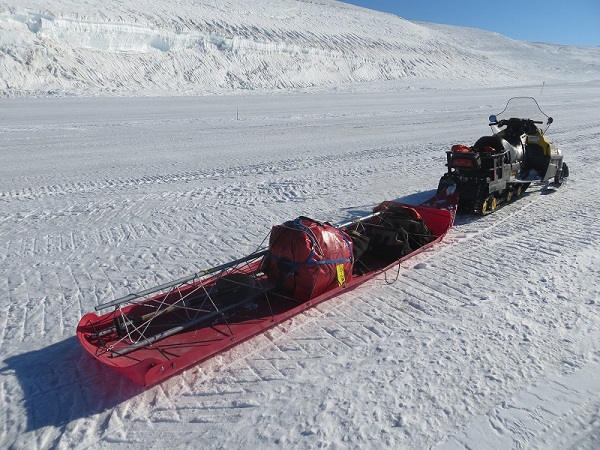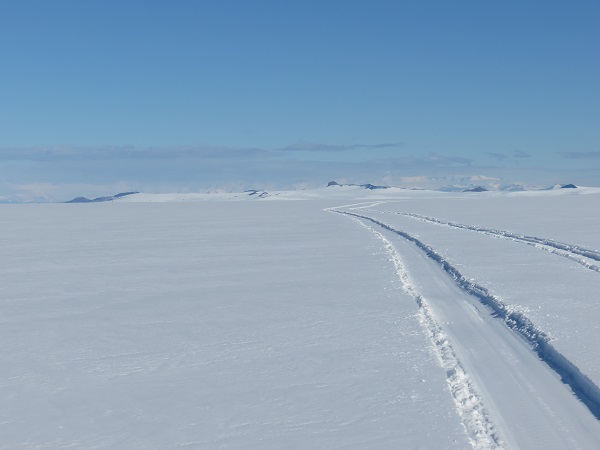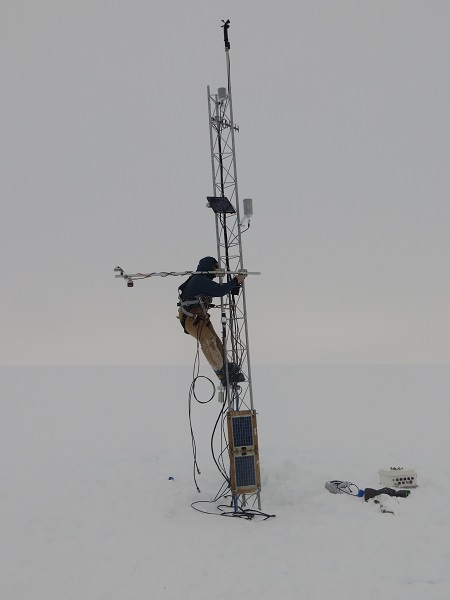So, the last week of this field season went and got itself in a big hurry, so much so that I’m no longer on the ice as I write this last post for our 2013-2014 field season.
There was a station that we had removed earlier in the season that we wanted to reinstall, Emma AWS. Originally, our last scheduled day to fly to this new site was Saturday 8 February. When Saturday came and went, we were put on the schedule for either the next Monday or Tuesday, whichever was a better weather day.
Unfortunately, the weather at Emma’s location was poor on Monday, but we did try flying to a different station, Vito AWS. As (bad) luck would have it, there were too many low clouds and fog at the site. We flew around, surveying the area, for about a half hour. The clouds were moving too quickly, so any opening we did see would soon close up before we could land. We never saw the station, and had we landed it would have been very difficult to see with the fog. We turned back to McMurdo.
Since we flew on Monday, that left Tuesday for us to snowmobile out to Windless Bight AWS to raise the station. There was a lot to do to prep for the trip: get the cargo ready and out to the snowmobiles by Scott Base, get some cargo supplies from town like a sled and survival bag, then load up everything. On top of this all, we had recently found out that Willie Field AWS, a station a few miles out on Pegasus Road, had some issues with the pressure readings that we needed to go check up on. It was feasible for us to visit Willie before Windless in the same day, and that’s what we did on Tuesday.
Of course, we weren’t able to fix everything on the first visit to Willie, so we had to go back on Wednesday. But before that we still had to do our work at Windless. We needed to raise the station, and that involved digging out the battery box, removing the instruments and upper-most tower section, then installing an additional tower section below the original. So the station went from about 7 feet high to 17 feet.
Driving out there was actually quite enjoyable. It was sunny, which I think makes it worlds better than driving when it’s cloudy because you can actually see the surface. Plus the scenery looks better.
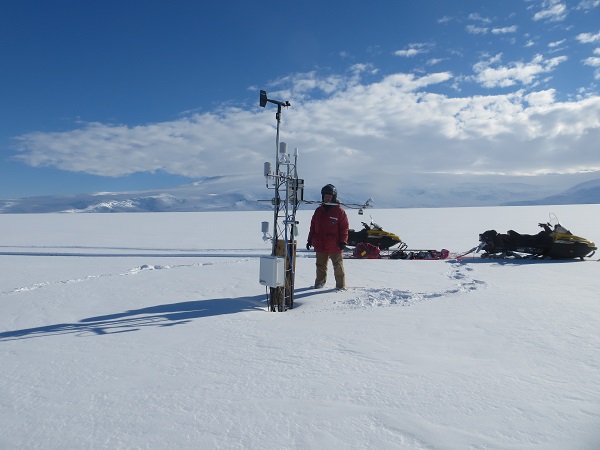
Lee scoping out the station. It definitely needed to be raised; there was at least 3 feet of snow accumulation in one year.
Clouds started rolling in a couple hours into our work. It started innocently enough, with the sun being blocked for a few minutes at a time. Then the sky was completely overcast. Eventually, we noticed that land features on the horizon would go in and out of view, an indication that there was snow around. With about an hour of work left, the wind started picking up (at *Windless* Bight, of all places!) and flurries started falling.
We kept plugging away, and when we were just plugging the last of the instruments in, it started snowing. Lightly at first, but it became quite heavy, with a strong northeasterly wind (I believe). When Lee climbed up the tower to get measurements of the instruments, the tape measure was whipping and snapping in the wind, and it was very intense.

The completed Windless Bight AWS. At this point, I just wanted to take this quick picture and get out of there so we could make it back to town. The best indication of the weather in this picture is the fact that you can’t make out the horizon at all.
We radioed in to McMurdo to make sure the weather was good enough for us to travel in. They said it was good in McMurdo, but that it wasn’t going to get any better at Windless for a while. We are fairly certain that it was Condition 2 weather when we left (mostly due to visibility; the visibility was less than 1/4 mile). The thought crossed my mind whether we were going to have to open the survival bag and pitch a tent for the night. Since we could still see the flags marking the route back to McMurdo (thank goodness for flags!) we decided to give it a shot and head back.
For the first 5 or 10 miles of the ride, all we could see were the flags marking our route and a slate of white. It was an interesting feeling. The winds were blowing the snow across our sleds, and at times I could hardly see Lee as I followed him because of all the fresh snow he was whipping up. Eventually the sun shone through the clouds, though the snow still fell. As we got back on Pegasus Road, the snow stopped and there were only high clouds above. We even saw what appeared to be a snow devil on the horizon. That was sweet! We couldn’t get close enough to get a good picture of it though. When we parked our snowmos, we noticed some sun dogs!
So, when it seemed like the drive back to town would be stressful, it was actually almost as enjoyable as the ride out. One part that was tiring, though, was walking back to town from the snowmo depot. It took us a little over an hour, as we carried our bags and trekked up the hill with our cold weather gear on. This was made especially difficult because it was already at the end of a 12-hour day. It was long, but it was well worth the work.
Once we got the problems fixed with Willie, we had to pack all of our stuff into our orange shed for storage over the winter, as well as clean our lab and our dorm rooms. The work never seemed to end! But we got all of that done, and on 13 Feb, the day before we left, there were some incredible mirages, fata morgana I believe, on the horizon.
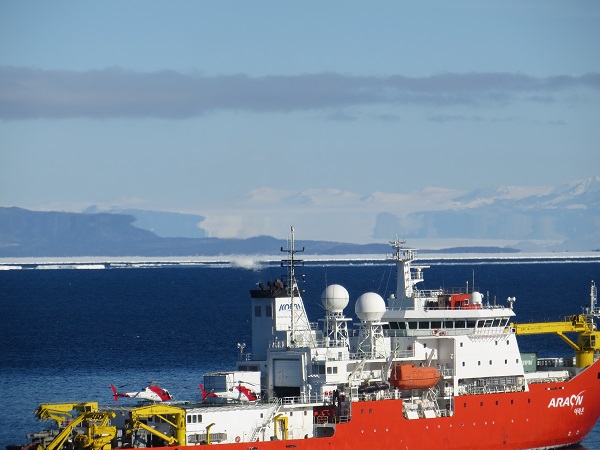
Fata morgana, evident above the ship on the horizon. The mountains definitely do not look like that!
Our day of redeployment finally came on Friday 14 February, and of course Antarctica had one more trick for us. It snowed pretty much all day, but fortunately our plane was still able to take off.
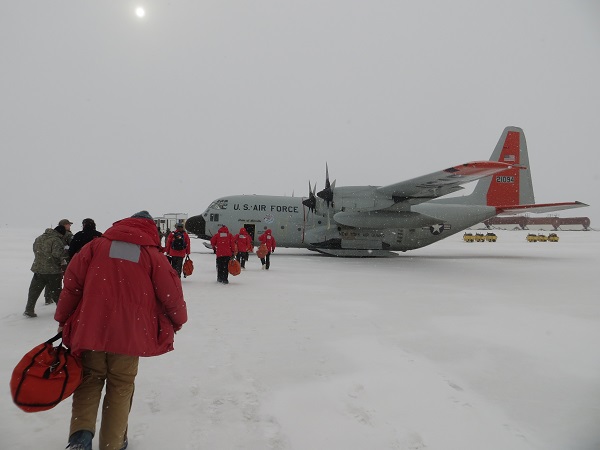
Lee, in the foreground, and everyone else boarding the LC-130 for the flight north to Christchurch, New Zealand. You can see the snow, but the plane was still able to take off with no difficulty.
After about 7.5 hours, we landed in Christchurch! It was an overall smooth way to end a relatively successful field season, if you ask me.
I had a great time on the ice this year. It was good to spend more time in Antarctica. I got much more experience doing our weather station work, and as a result got many more cool experiences under my belt. And this year may forever be known, for me, as the year of the penguin. After not seeing any last year, I got my fair share of penguin sitings this year and then some!
With that, I’ll sign off on the blog for the 2013-2014 field season. It has been fun keeping you all updated on things, and I’ll be doing the same when I’m on the ice again next year!
Cheers!
Dave


